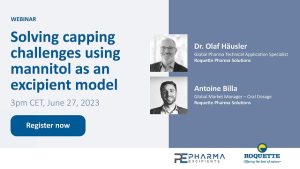Development and in vivo evaluation of nanoemulsions for oral delivery of low molecular weight heparin

Abstract
Aim
The aim of this study was the development and in vivo evaluation of different types of nanoemulsions for oral delivery of low molecular weight heparin (LMWH).
Methods
Nanoemulsions (NE) were developed consisting of mainly non-digestible components and variations of polyglycerol-, PEGylated or zwitterionic surfactants. To incorporate LMWH in the oily droplets, hydrophobic ion pairs were formed with several cationic surfactants. Loaded and unloaded NE were evaluated for their size, zeta potential, stability towards pancreatin, hemolytic and toxic properties. Finally, an in vivo study on oral LMWH delivery was performed.
Results
Droplet size of all formulations was below 150 nm with a PDI <0.4. Highest logK1-butanol/water was obtained for the complex of LMWH and didecyldimethylammonium bromide (HIP). This complex was incorporated into NE containing polyglycerol- and PEGylated surfactants up to a concentration of 5% (m/v) and in zwitterionic NE up to 10% (m/m). NE containing polyglycerol-surfactants were digested to a higher extent than NE containing PEGylated surfactants. The zwitterionic NE without glycerides did not show any lipolysis but the zwitterionic NE which contained high amounts of glycerides was rapidly degradable. NE with polyglycerol-surfactants were less toxic and hemolytic than NE with PEGylated surfactants and zwitterionic NE. Toxic potential increased with HIP-loaded formulations. When performing in vivo studies, oral bioavailability of LMWH was increased up to 2.6% with non-digestible NE.
Conclusion
According to these results, non-digestible nanoemulsions improve oral bioavailability of LMWH more efficiently than biodegradable formulations.
Download the full article as PDF here Development and in vivo evaluation of nanoemulsions for oral delivery of low molecular weight heparin
or read it here
Materials
LMWH (Enoxaparin Becat 4000 I.E. 40 mg/0.4 ml) was purchased from Rovi GmbH (Holzkirchen, Germany). DOTAP chloride and Lipoid P LPC 80 (lysophosphatidylcholine from soybean, 80%) were obtained from Lipoid GmbH (Ludwigshafen, Germany). Imwitor 742® (medium chain partial glycerides, glyceryl caprylate/caprate Type I) was purchased from IOI Oleo GmbH (Hamburg, Germany) and didecyldimethylammonium bromide from Tokyo Chemical Industry Co. (Tokyo, Japan). Miglyol® 812 (medium chain triglycerides) was bought from Caesar & Loretz GmbH (Bonn, Germany) and sodium taurodeoxycholate hydrate (NaTDC) was bought from Biosynth (Bratislava, Slovakia). Dodecylamine HCl, dodecyltrimethylammonium chloride and cholesterol were obtained from ThermoFisher GmbH (Kandel, Germany). Tegosoft® PC41 (polyglyceryl-4 caprate) and Tego® solve 55 (polyglyceryl-3 caprylate/caprate/succinate (and) propylene glycol) were kindly provided by Evonik (Hamburg, Germany) as free samples. Natragem™ S140 NP (polyglyceryl-4 laurate/sebacate (and) polyglyceryl-6 caprylate/caprate (and) aqua) was supplied by Croda Inc. (Nettetal, Germany). FaSSIF powder was obtained from Biorelevant (London, United Kingdom). Pancreatin from porcine pancreas [8x USP specifications], L-alpha-phosphatidylcholine from egg yolk [60%] (PC), Kolliphor EL® (PEG-35 castor oil) and all other chemicals were purchased from Sigma-Aldrich (Vienna, Austria) or other commercial sources.
Katrin Zöller, Flavia Laffleur, Victor Claus, Patrick Knoll, Dennis To, Andreas Bernkop-Schnürch, Development and in vivo evaluation of nanoemulsions for oral delivery of low molecular weight heparin, Journal of Drug Delivery Science and Technology, Volume 86, 2023, 104686, ISSN 1773-2247, https://doi.org/10.1016/j.jddst.2023.104686.
Visit our new Webinar:
Solving capping challenges using mannitol as an excipient model
Get more information & register here:


